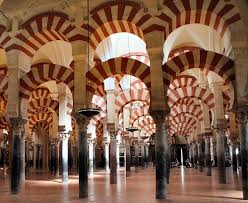
The centuries of Muslim dominance are often thought of as a ‘golden age’ in which Muslims, Jews and Christians lived in comparative peace. It’s often upheld as an example of what could and perhaps should be possible in the 21st century. It was certainly a golden age of learning where literature, poetry and philosophy flourished. Jews fared much better under Islamic rule than, I’m sorry to say, they did under Christian rule. Like Christians they were able to practise their religion and contribute to society. But it was only Muslims who were seen as full citizens and certain restrictions were placed upon both Jews and Christians who were forced to live in a state of dhimmitude, paying a special tax to the Muslim rulers with restrictions on clothing, such as the wearing of a distinctive badge, and the building of synagogues and churches.
‘Golden Ages’ are often a reflection of idealism and aspiration rather than of reality for there were tensions in the region with Islamic rulers fighting one another for power and prestige and waging war on Christians in other parts of Spain. Jews, Christians and Muslims did live in comparative peace but only by accepting Muslim rule and some years were more peaceful than others. Persecutions did sometimes happen. When Andalusia was reconquered by the armies of the Christian monarchs, Isabella and Ferdinand, the age of tolerance was at an end. Andalusia became a dangerous place for Muslims and Jews.
As a Christian I was able to marvel at the beauty, simplicity and symmetry of the Moorish architecture, the peace of the wonderfully laid out gardens and freshness of the running waters. These spoke to me much more of the presence of God than the great Cathedrals built with the money which came from Christopher Columbus’ conquest of the New World. The ornate altars covered in gold leaf, the gold and silver of the cathedral treasures, the grandeur of the buildings themselves were overwhelming and rather too much. It was hard to look at such opulence and think of the poverty that exists outside their walls. It was hard too to remember the consequence of the Spanish colonisation of the Americas which introduced diseases previously unknown to the indigenous people, decimated and impoverished the population, traded with them for gold and attempted to force them into accepting Catholic belief and practice.
It was hard to remember how the Pope at the time supported this venture and passed a decree known as the Doctrine of Discovery which gave Christian rulers the right “to invade, capture, vanquish, and subdue all Saracens, pagans, and other enemies of Christ, to put them into perpetual slavery, and to take away all their possessions and property.” This was the injustice of a time which considered those who weren’t Christian as less than human. How is it possible to give glory to God by great cathedrals and yet ignore and subdue human beings who were made in the image and likeness of God? And yet it’s important not to judge an earlier age by present understandings. We’re all limited by the era in which we live and at that time grand cathedrals were built to give glory to God and remind worshippers of their creatureliness. It’s the same with other religions. Hindu and Buddhist Temples as well as Mosques and Gurdwaras have been built on a large scale in spite of the poverty of people living around them. Often they have given worshippers a sense of being taken out of their mundane lives into another reality.
Looking for remnants of the Jewish community was hard. In both Seville and Granada there was a Jewish area, known for its narrow streets with its bustling cafes and restaurants but no sign of Jewish life. Cordoba did have the ruins of a small synagogue and a statue of Maimonides, the great medieval philosopher, much respected by the Jews, whose understanding and systemisation of the Jewish faith is still used today. He was born in Cordoba but had to leave with his family when one Muslim dynasty abolished dhimmi status and offered only conversion to Islam, death or exile. Jews are present in Andalusia but more in their absence than in their presence.
Evidence of Islam is everywhere – in the decoration of buildings, in the great palace of the Alhambra but particularly in the magnificent Mosque, the Mesquita, of Cordoba. Wonderful red and cream pillars give a sense of freedom and, even with the crowds of visitors, the Mosque is amazingly prayerful. At its peak the Mosque was able to house 20,000 Muslims at prayer. It must have been an amazing sight. It’s the only ancient Mosque in Spain and amazingly was not pulled down when the governance of Spain passed into Christian hands. Rather a cathedral was built within it – a great Gothic cathedral with its gold altars and vaulted ceilings – rather crude and obscene compared to the simple lines of the Mosque. This again is not unusual. The space already had a Christian Church which was destroyed to build the Mosque and in fact this has only been saved by having a Christian Church built within it - a bit like St Sophia in Istanbul with a Mosque built inside a Cathedral.
There’s much more to be said of course but I’m left with feelings of awe at the beauty and wonder of it, sadness at the history behind it and a recognition of what dialogue and cooperation can do for a society, if only we were committed to it. I don't think this is the last word on Andalusia.



 RSS Feed
RSS Feed
